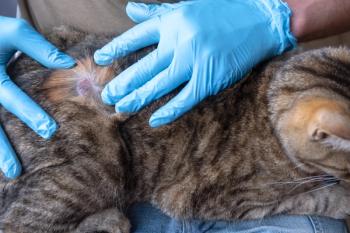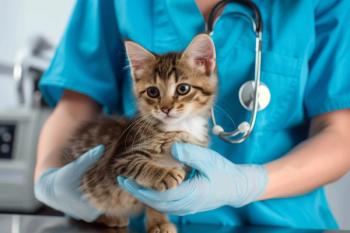
DVMs cite growth despite recession
Cleveland-Numbers of active clients and revenue are both on the upswing, veterinarians say. But a disparity still exists in pay between men and women.
Cleveland-Numbers of active clients and revenue are both on the upswing, veterinarians say. But a disparity still exists in pay between men and women.
Table 1: Mean average client transaction and Table 2: What is your current average client transaction?
An exclusive DVM Newsmagazine survey says that the majority of veterinarians experienced growth despite a recessionary economy. But for some practices, growth has been flat or trending downward. This month's report focuses on finance including gross and net revenues, service categories, client-base size and product category mark-ups.
On average, veterinarians were taking home $75,000 a year. The mean for practice owners was $80,000. Men were also earning more than their women counterparts. The data were examined by both year of graduation and position in the practice to determine whether the trend was based on either age or position in the hospital. Some of the results included:
Income: Nothing but net
- Average for men practice owners: $95,000.
- Average for women practice owners: $60,000.
- Average for women graduating between 1970-79: $85,000.
- Average for men graduating between 1970-79: $100,000.
Other personal compensation results include:
- Graduating between 1980-89
Men: $80,000; women: $60,000.
- Graduating between 1990-99
Women: $56,000; men: $75,000.
- Graduating between 2000 to present:
Men: $63,000; women: 56,000.
The mean for the average client transaction (ACT) was $97.3, which was up from $85 in DVM Newsmagazine's 2000 survey (Table 1). In the 2003 survey, exclusive small animal practitioners averaged $103, while predominantly small animal practitioners were at $76 and mixed animal practitioners, $78.
Average client transaction
Table 3: Was last year's net practice revenue greater than, about the same as, or less than previous year? and Table 4: Compared to 3 years ago is your practice now seeing more, less or the same number of patients in an average week?
When the data was cross-tabulated by practice size, the average ACT increased with practice size. The data shows that the mean ACT for one-doctor practices is almost 28 percent less than that of a four-plus doctor clinic. The mean ACT for one-doctor practices is $92.8, for two-doctor practice $95.1 and in practices with four or more doctors it jumps to $118.80. Table 2 spells out the mean ACT based on practice size.
A vast majority (88 percent) of veterinarians say this amount has increased over the past three years. For 35 percent of respondents the ACT has increased significantly (more than 15 percent). More than half of the respondents say it has increased a little, while about 10 percent say it has stayed about the same.
Table 5: To what do you attribute any changes in your client base, number of patients seen or transaction amount?
Average gross revenues also jumped in this survey in comparison to 2000 results. On average, gross revenues were $714,000, while the average for 2000 was $664,000. Eighty-one percent of practitioners also expect an increase in gross revenues for the next three years. The average increase expected is 9 percent over the next three years.
Gross/net income
Net revenues are also on the rise, veterinarians add. In fact, 67 percent of surveyed practitioners say net revenue is greater than the previous year (Table 3, p. 15).
Table 6: Which statement most closely reflects your practice and client base? and Table 7: What percent of your practice's annual gross comes from each of the following categories, and where do you anticipate these percentages will be 3 years from now?
About 78 percent of respondents say their client bases have increased over the past three years. In fact, about 35 percent of responding veterinarians say it has increased significantly (15 percent or more).
Location, location, location
In contrast, 22 percent of veterinarians say their client base has either decreased or stayed about the same.
Of the respondents located in the Northeast, about 57 percent say client bases have grown significantly. Only 30 percent of responding practitioners in the Midwest said the same thing.
On average, veterinarians believe their practice geographic service area is 20 miles. Out of the respondents about 35 percent say the practice's geographic area is still under 10 miles.
Methodology
Veterinarians were also asked: "Compared to three years ago is your practice now seeing more, less or the same number of patients in an average week?" About one-quarter of the respondents say it has been a significant increase. Another 40 percent, say it has been somewhat of an increase over the three-year span. But 23 percent of the practitioners responding say they have seen a significant drop in patients, another 11 percent say it has been somewhat less, while only 2 percent believe it has stayed the same (Table 4, p. 15).
A greater percentage of solo practitioners cite a significant increase in patients seen each week. When the data was broken out by practice size, 26 percent of solo practitioners say their patient base has increased significantly; 23 percent in two to three doctor practices and 18 percent in four or more doctor practices.
Table 8: How do you price vaccinations: one charge for vaccine, separate charge for exam; or one price for both?
Table 5 (p. 16) offers the most commonly cited reasons for changes to a practice's client base, number of patients seen and transaction amount.
Veterinarians were asked: Which statement most closely reflects your practice and client base?
Practice philosophy
About 70 percent of responding veterinarians say they take "all paying clients, providing them with whatever level of service they request/require." About 25 percent of the DVMs surveyed say the hospital offers primarily high-quality diagnostic medicine and surgery, and tend to have clients for whom cost of treatment is not a major factor (Table 6).
Only 5.7 percent of the respondents say, "We primarily provide basic medical services, price our medical services low and attract cost-conscious pet owners."
Table 9: What is your usual mark-up to clients on each of the following product categories?
When breaking the data out by region, a statistical difference was noted in the high-end practice category in the Mountain and Pacific and South regions. About 27 percent of the respondents in the South say they tend to have clients for whom cost is not a major factor. In the Mountain and Pacific region the number jumps to 29 percent. About 17 percent of veterinarians in the Northeast say cost is not a major factor with clients.
On average, veterinarians are seeing 72 patients a week. Differences were noted by practice type. Exclusive small animal veterinarians are seeing an average of 69 patients a week, while mixed animal practitioners report seeing 87 and predominantly small animal, 83.
Workload
Some interesting practice size differences were also noted by respondents when asked about the numbers of patients they personally see each week, including:
- Less than $250,000: 53.5
- $250,000-$499,000: 84.4
- $500,000-$749,000: 79.5
- More than $750,000: 72.1
The numbers of patients seen by the size of practice include:
One-doctor practice: 85
Two-three doctor practice: 183
Four or more doctor practice: 364
Veterinarians believe that income from annual examinations/vaccinations will slip a little in the next three years, but diagnostics will play an increasingly important financial role for practices.
Service mix
Table 7 (p. 16) outlines results from four consecutive DVM Newsmagazine surveys asking veterinarians to assign percentages to service categories. Small incremental decreases in annual examination/vaccination revenues are projected in comparison to slight shifts to diagnostics, the survey says.
Veterinarians are also separating charges for vaccines and physical examinations. In the 2003 survey, 62 percent of veterinarians say they separate charges on the bill. In 1994, only 46 percent of veterinarians reported the same practice. (See Table 8.)
When asked: "If requested will you provide just the vaccination without an exam or just a cursory exam? The majority of veterinarians say no, but the other 40 percent said they would.
Veterinarians have dropped mark-ups on product prices in certain categories, especially vaccines/biologicals. For the 2003 survey, the average mark-up on vaccines was 244 percent, while in 1997 it averaged 373 percent. The falling prices signify a 52 percent decrease over the six-year period. (See Table 9.)
Product mark-ups
When cross-tabulated by practice size, the most significant price drop can be seen in four-plus doctor practices. In 1997, the vaccine mark-up for this size of a practice was 372 percent, in 2003, the mark-up price dropped to 172 percent.
Newsletter
From exam room tips to practice management insights, get trusted veterinary news delivered straight to your inbox—subscribe to dvm360.




